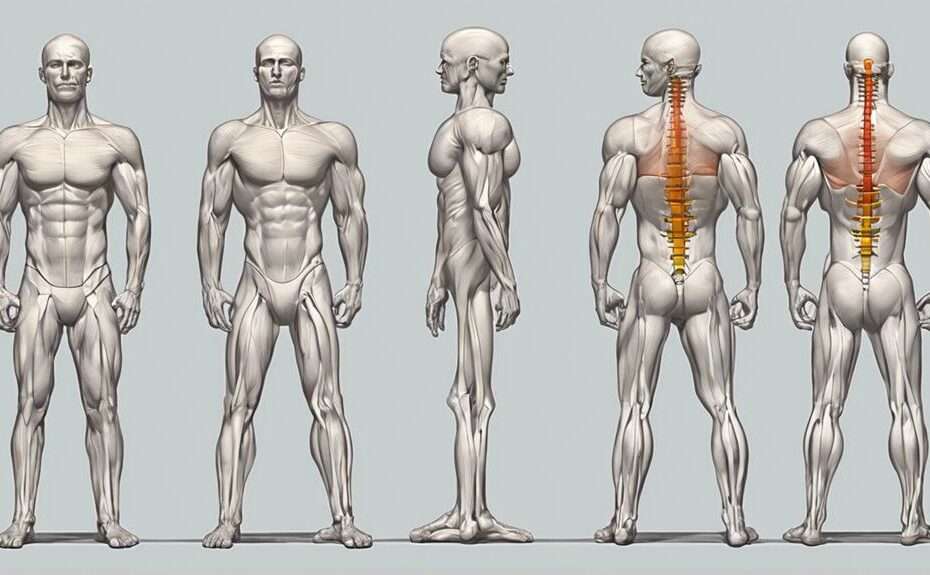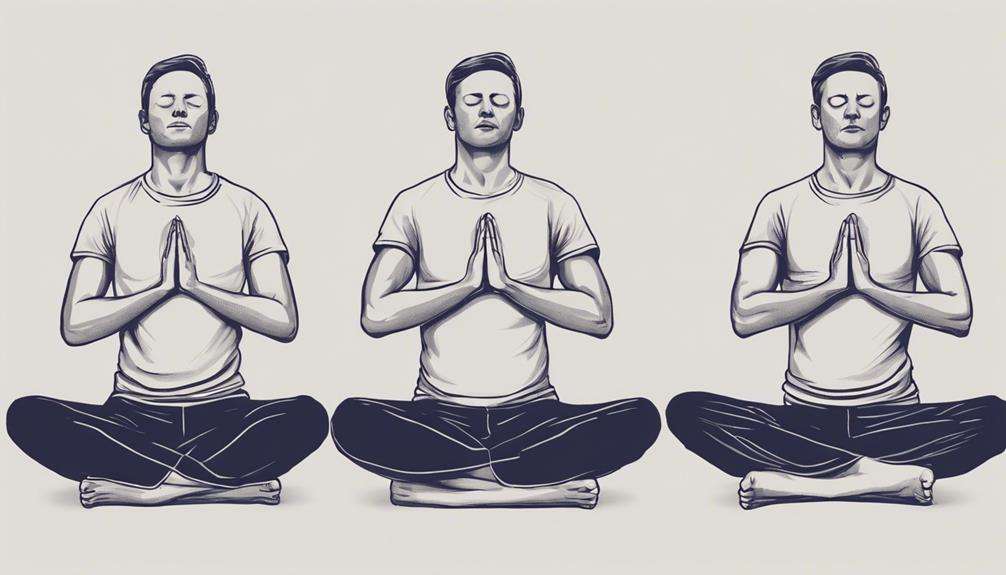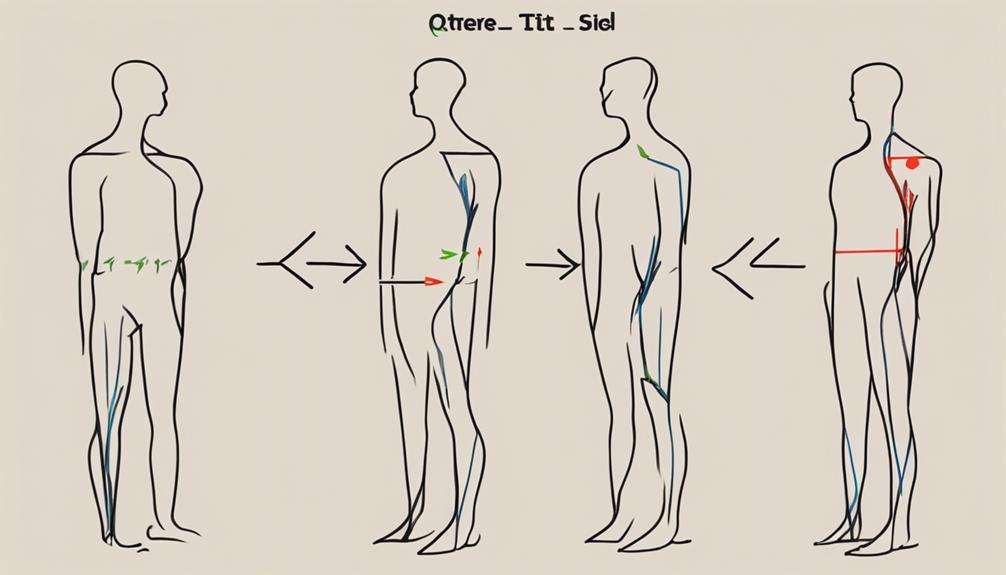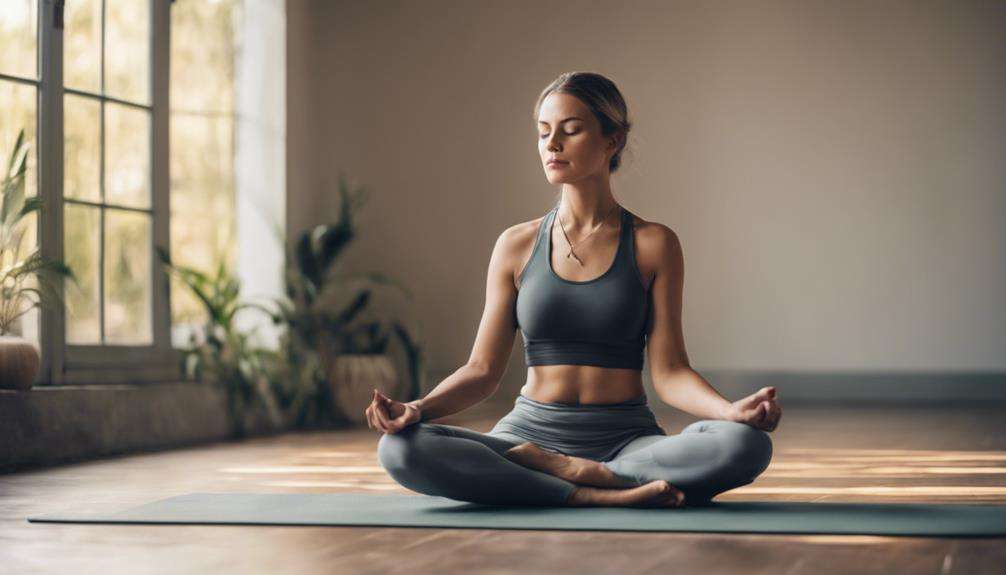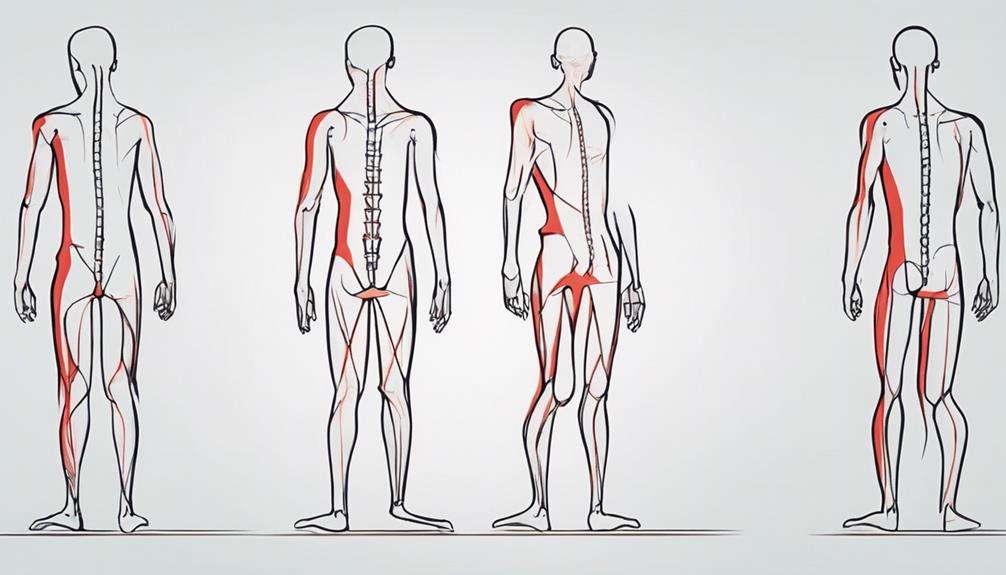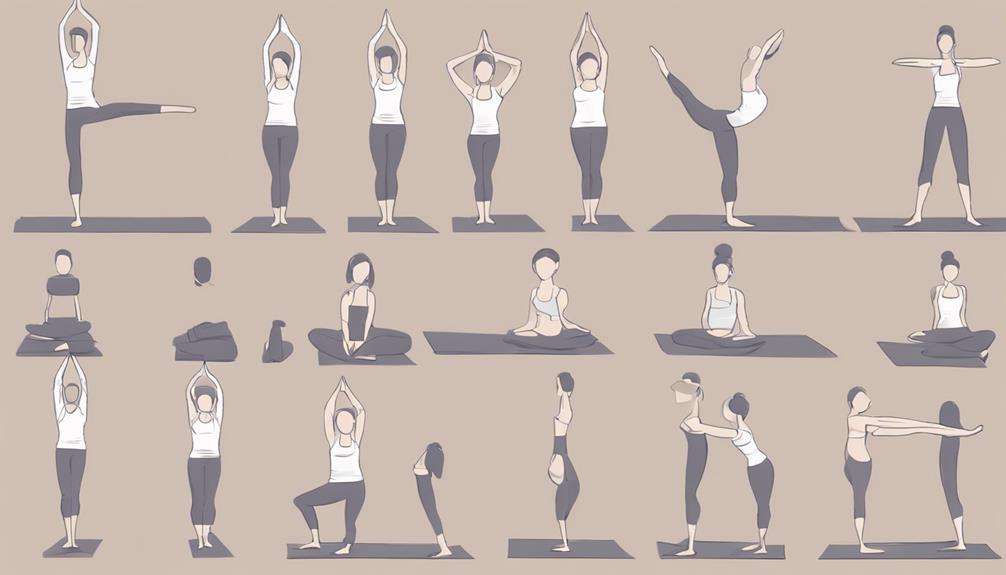Imagine your body as a finely tuned instrument, each pose a gentle adjustment to bring it back into harmony.
These 7 poses hold the key to unleashing better posture and wellness, offering a pathway to a stronger core, improved alignment, and increased body awareness.
As you explore each pose, you'll discover the transformative power they hold in enhancing your physical well-being.
Key Takeaways
- Mountain Pose and Eagle Pose improve posture and strengthen key muscle groups for better alignment.
- Plank Pose targets core muscles, enhancing stability and spinal support.
- Cat-Cow Stretch and Bridge Pose enhance back strength, flexibility, and overall spine health.
- Cobra Pose boosts spinal flexibility, back strength, and overall wellness for better posture.
Mountain Pose
Mountain Pose, also known as Tadasana, aligns your body from head to toe, improving posture and strengthening key muscle groups. This foundational yoga pose serves as a cornerstone for enhancing alignment and cultivating body awareness.
By focusing on maintaining a neutral spine, engaging the core, and grounding through the feet, Mountain Pose helps in improving posture and balance. The practice of this pose not only strengthens the thighs, knees, and ankles but also supports the back muscles, potentially alleviating back pain over time.
Cat-Cow Stretch
To enhance spinal flexibility and promote better posture and alignment, incorporating the Cat-Cow Stretch into your routine can be highly beneficial. This stretch involves moving between two poses: the Cat Pose, where you arch your back upward like a stretching cat, and the Cow Pose, where you drop your belly towards the mat while lifting your head and tailbone. By flowing between these poses, you increase spinal mobility, which can help alleviate back pain and stiffness. The Cat-Cow stretch not only relieves tension in the neck and shoulders but also enhances coordination and body awareness.
Regular practice of the Cat-Cow stretch stimulates the abdominal organs, aiding in digestion, and improves balance and stability. This pose is excellent for those looking to improve their posture, as it aligns the spine and encourages proper positioning of the back and neck. By incorporating the Cat-Cow Stretch into your daily routine, you can experience the benefits of reduced pain, increased flexibility, and enhanced overall wellness.
Plank Pose

Plank Pose offers numerous benefits for your core muscles, improving strength in the abdominals, lower back, and shoulders. Ensuring correct alignment in Plank can help engage the muscles that support proper posture.
Additionally, there are various modifications and variations of Plank Pose to suit different fitness levels and needs.
Benefits of Plank
Engaging in regular practice of the plank pose can greatly strengthen core muscles, improve posture, and reduce the risk of lower back pain.
Plank pose targets various core muscles, such as the abdominals, obliques, and lower back, enhancing overall spinal stability. By holding a plank, you engage multiple muscle groups simultaneously, promoting better body alignment and posture.
The activation of the transverse abdominis during plank strengthens this important core muscle essential for supporting the spine and maintaining good posture. Consistent incorporation of plank into your routine not only increases strength but also enhances balance and alignment.
Embrace the benefits of plank pose to fortify your core, improve posture, and safeguard against lower back pain.
Correct Plank Alignment
Proper alignment in the Plank Pose is important for strengthening your core muscles, which are essential for maintaining good posture and overall stability.
To achieve correct alignment, make sure your wrists are directly under your shoulders, engage your glutes and abdominal muscles, and keep your body in a straight line from head to heels. This alignment not only helps in building muscle endurance but also provides essential spinal support.
Holding the Plank for 20-30 seconds, focusing on proper alignment, can prevent overarching or sagging of the spine.
Consistent practice of the Plank Pose will improve your body alignment, posture, and overall stability, making it a valuable addition to your fitness routine.
Variations for Plank
To enhance your core workout and target different muscle groups, explore various plank variations that offer a balanced approach to strengthening your body.
Try the Forearm plank to reduce stress on wrists while engaging core muscles effectively.
The Extended plank with leg lifts challenges stability and strengthens your entire body.
Incorporate the Plank with shoulder taps to improve shoulder stability and enhance core engagement.
For dynamic options, consider plank variations like plank jacks or mountain climbers which add cardio benefits to core strengthening.
Side plank is excellent for targeting specific muscles and enhancing balance.
Bridge Pose
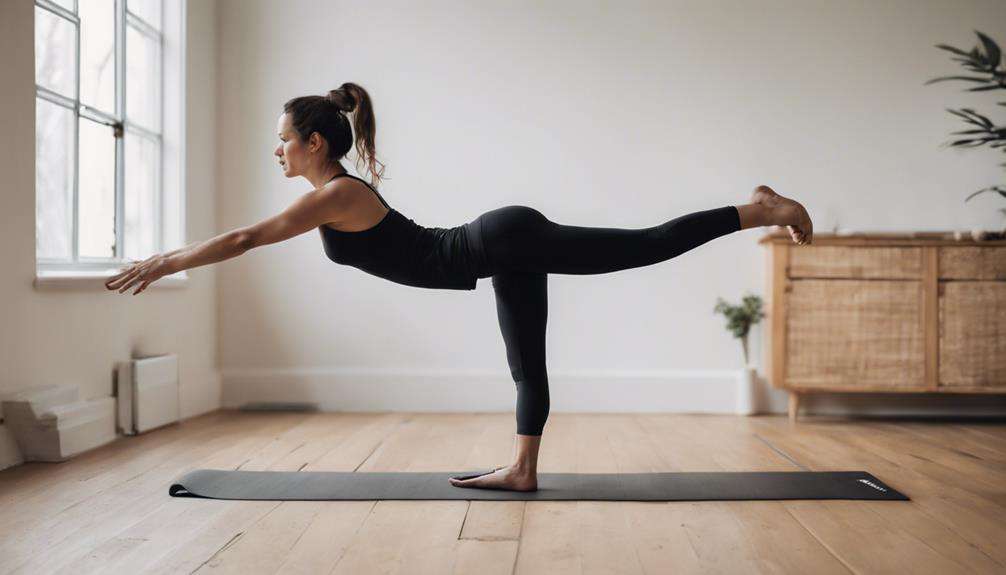
When practicing Bridge Pose, you can experience various benefits such as strengthening the lower back muscles, glutes, and hamstrings.
Focus on proper alignment to optimize the pose's effectiveness in improving posture by opening the chest and shoulders.
Variations and modifications can cater to different levels of practice and help you explore the pose's full potential.
Benefits of Bridge Pose
Strengthening the lower back muscles, Bridge Pose is a beneficial yoga posture that plays a key role in enhancing posture and overall wellness. This pose not only targets the lower back muscles but also improves spine flexibility and mobility.
By engaging the glutes and core muscles, Bridge Pose enhances stability and support for your spine, promoting better posture. It aids in aligning the pelvis correctly, which is essential for overall back health.
Additionally, practicing Bridge Pose regularly can help alleviate lower back pain and contribute to a stronger, more resilient back over time. Embracing Bridge Pose in your routine can lead to a more stable and aligned spine, ultimately enhancing your overall wellness and posture.
Proper Alignment Tips
For perfect alignment in Bridge Pose, make sure your feet are positioned hip distance apart. As you lift your hips towards the sky, engage your glutes and core muscles to support your lower back. Keep your shoulders relaxed and your neck in a neutral position to prevent strain.
This alignment not only strengthens your lower back muscles but also promotes better posture and spinal alignment. Focus on breathing deeply and evenly to enhance relaxation and stability while holding Bridge Pose. By following these proper alignment tips, you can maximize the benefits of this pose and improve your overall wellness.
Variations and Modifications
To enhance your Bridge Pose practice, consider exploring various modifications and adaptations to cater to different levels of flexibility and strength. Bridge Pose is an excellent posture for strengthening the lower back, glutes, and hamstrings while opening up the chest and shoulders.
By incorporating modifications like using a block under the sacrum, individuals of all levels can benefit from this pose. These adjustments can help alleviate back pain, improve spinal flexibility, and enhance core strength.
Regular practice of Bridge Pose not only improves posture but also supports overall stability. Whether you're a beginner or more advanced practitioner, modifying Bridge Pose can help you target specific areas and make the most out of this beneficial posture.
Eagle Pose
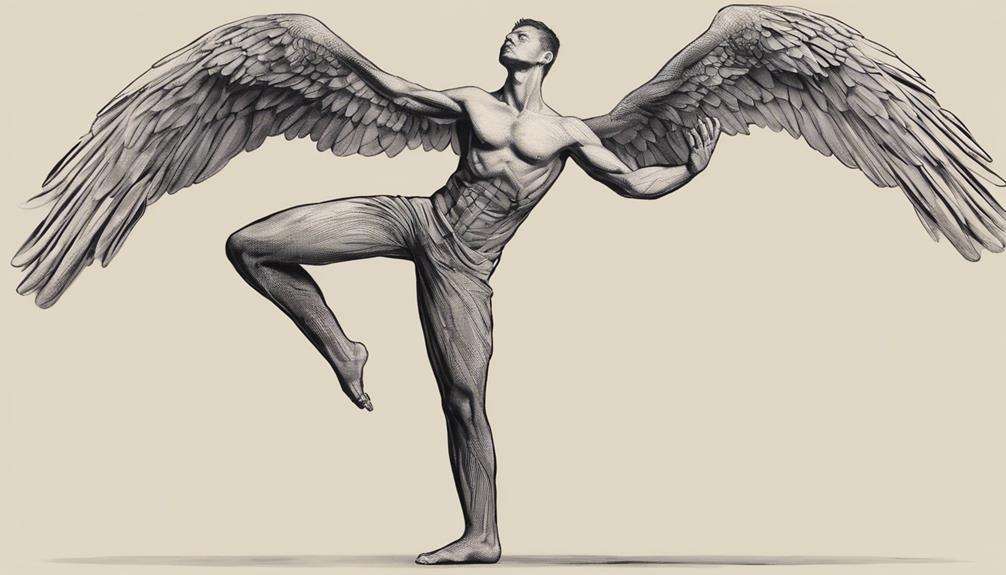
Eagle Pose, known as Garudasana, enhances posture and overall wellness by strengthening key muscle groups and improving body awareness. This pose targets the shoulders, upper back, thighs, and core muscles, offering a full-body workout.
By practicing Eagle Pose, you can improve your focus and concentration as you work on the balance and alignment required for this posture. The shoulder and upper back stretch in Eagle Pose helps relieve tension and increase flexibility in these areas, promoting better posture over time. Additionally, engaging in this pose regularly can enhance shoulder mobility, allowing for a wider range of motion.
The activation of core muscles during Eagle Pose not only supports the spine but also aids in maintaining proper alignment. Incorporating Eagle Pose into your routine can lead to improved posture, increased body awareness, and a stronger, more balanced physique.
Shoulder Opener
Engage your shoulders and chest effectively with the invigorating Shoulder Opener yoga pose. By interlacing your hands behind your back, you can stretch your shoulders and open up your chest, promoting shoulder flexibility and mobility. This pose not only reduces tension in the upper body but also aids in improving posture and enhancing upper body alignment.
In the Shoulder Opener pose, as you roll your shoulders back and extend your arms overhead, you also stretch your hamstrings, providing added benefits beyond just the upper body. Regular practice of this pose can lead to increased flexibility in the shoulders, making daily movements easier and more fluid.
Cobra Pose
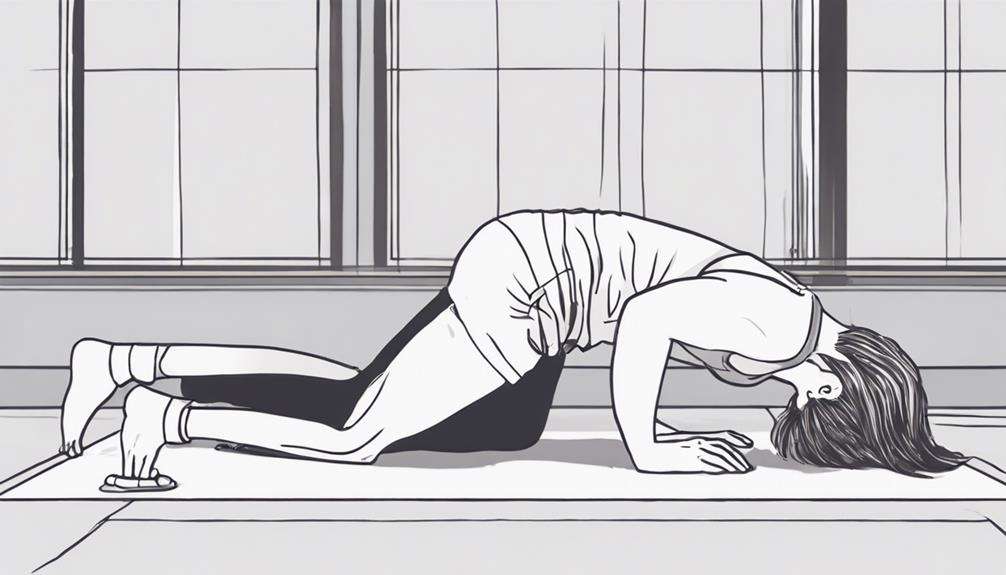
Strengthen your back muscles and improve spinal flexibility with the invigorating Cobra Pose. This posture not only enhances the flexibility of your spine but also works on aligning your back, promoting better posture.
By engaging in Cobra Pose, you aren't only stretching your chest and abdomen but also stimulating your abdominal organs, which can lead to improved digestion and overall wellness. Additionally, practicing Cobra Pose offers stress relief and fatigue reduction while boosting blood circulation throughout your body.
Regular practice of Cobra Pose can result in a more robust back and core muscles, enhancing your overall strength and stability. The combination of back strengthening, spinal flexibility, posture improvement, stress relief, and enhanced blood circulation makes Cobra Pose a beneficial addition to your wellness routine.
Embrace the Cobra Pose to enjoy its multifaceted benefits for your body and mind.
Frequently Asked Questions
Can You Correct Years of Bad Posture?
You can correct years of bad posture by incorporating posture exercises, adjusting daily habits, seeking chiropractic care, creating an ergonomic workspace, considering massage therapy, practicing mindful movement, attending Pilates classes, maintaining a stretching routine, and focusing on spinal alignment.
What Yoga Pose Teaches Correct Posture?
Incorporating Mountain Pose into your routine can teach correct posture by aligning your body from head to toe. It focuses on grounding through your feet, lengthening the spine, and engaging core muscles for perfect alignment.
What Are the 6 Ways to Have Good Posture and Technique?
To maintain good posture and technique, focus on sitting ergonomics, standing alignment, exercise benefits, core strength, neck position, shoulder alignment, breathing techniques, spinal health, and a stretching routine. These practices support overall wellness and reduce postural strain.
Which Asana We Can Improve Your Posture?
Standing poses like Virabhadrasana 1 strengthen muscles for better alignment. Back stretches such as Gomukhasana open the chest. Core strength from Navasana stabilizes your posture. Shoulder alignment improves with Virasana. Hip openers enhance spinal alignment.
Conclusion
Incorporate these 7 yoga poses into your daily routine to improve your posture and overall wellness.
By practicing:
- Mountain Pose
- Cat-Cow Stretch
- Plank Pose
- Bridge Pose
- Eagle Pose
- Shoulder Opener
- Cobra Pose
You can strengthen your core, relieve tension in your neck and shoulders, and promote better alignment.
Take the time to care for your body and see the positive impact on your physical health and general well-being.
